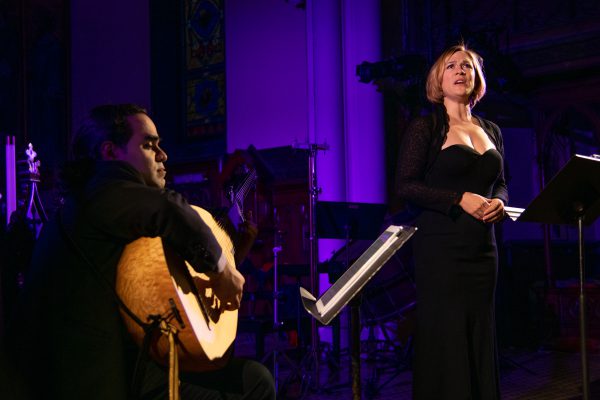Cantata Profana conjures mesmerizing “Visions of Silence”

Arash Noori and Alice Teyssier in Cantata Profana’s “Visions of Silence” on Friday night in Chelsea. Photo: Russ Rowland
For a composer as fine and singular as Salvatore Sciarrino, his presence on the New York concert scene is minor. So the past two nights have delivered the acutely welcome opportunity to enjoy a concentrated sample of his art.
One night after Ekmeles brought his 12 Madrigali to the U.S. for the first time, Cantata Profana presented his extraordinary Infinito nero to conclude a marvelous concert called “Visions of Silence” at St. Peter’s Church in Chelsea.
Of course, silence cannot be seen, and the actual experience of hearing silence shaped by music is far more involving, the ear being more evocative and responsive than the eye. Silence prepares music and, in concert, alerts the ear. Cantata Profana, with artistic director Jacob Ashworth, created a program that showed how fascinating a satisfying silence could be, but did so much more; it blazed a trail to Sciarrino’s concluding work, and showed how meaningless the idea of past and present is when music creates an infinite now.
In a near continuous flow, maintaining a performance attitude on stage even when changing personnel (there was no opportunity for applause until the very end), the ensemble played Alvin Lucier’s Music for Piano and Amplified Sonorous Vessels, then a song from Tarquinio Merula, Galina Ustvolskaya’s Symphony No. 5, Alessandro Piccinini’s Toccata cromatica for lute, and then Infinito nero.
The music came in waves, each moving toward the final moment. With Daniel Schlosberg at the piano and Cantata Profana clarinetist Gleb Kanasevich handling the sound engineering, Lucier’s piece came as a series of brief, plain musical statements, followed by shadowed echoes from the amplification. It set a stillness upon the concert.
Merula’s Canzonetta spirituale sopra alla nanna followed immediately. Arash Noori played the rocking two-note introduction on lute as if the alternating waves of Music for Piano had coalesced in one instrument. Soprano Alice Teyssier sang the lovely, passionate lullaby — this was a grounding and colorful performance.
That simplicity led into Symphony No. 5. Ustvolskaya’s voice is as unique as Sciarrino’s. She used short, rhythmically simple phrases and plain harmonies. Her sound is brutalist and stark—in this, her last symphony, the instrumentation is one tuba, one trumpet, one oboe, one violin, and one percussionist. She eschewed even the resonance of a drum for wooden mallets against a wooden box. The wild card is a recitation of the Lord’s Prayer (the symphony’s subtitle is “Amen”), delivered in Russian by Kanasevich.
The honesty and sense of determination in Ustvolskaya’s music are always compelling; one feels she is seeing herself unsparingly and is committed to a difficult path with no wavering. With Kanasevich’s urgent recitation, the experience was a rich one, and the touch of religious fervor on top of the composer’s edge of masochism piqued the senses for Sciarrino’s extraordinary piece.
Between Ustvolskaya and Sciarrino, Noori returned with the 17th century Toccata. Piccinini’s modulations were experimental in his day, and still sound extreme and daring to modern ears. They are skillful, logical, and graceful, and were an excellent last bridge that brought together past and present in Sciarrino’s masterwork.
Infinito nero is a representation and channeling of Saint Maria Maddalena de’ Pazzi, an ecstatic masochist who spent years lying on a cot, dictating her visions and premonitions to a group of novices who recorded them. She would spend long periods in silence, and then explode with a burst of such rapid speech it took four women to catch everything and another four to transcribe it.
Infinito nero is so quiet as to be on the edge of perception, and the ensemble’s control of that quiet, and silence, was impressive. For minutes at a time the only sound is the soft clicking of the oboe’s keys, paced with an exactitude that is the one thing that makes music out of what would be a Cage-ian listening experience.
So quiet is much of the music that a hissing radiator, heard somewhere behind a closed door at the back of the church, blended with the ensemble’s playing. Teyssier would break open into impossibly quick articulations of words and notes. The tension and drama of stasis and energy were strongly bolstered by Erin Earle Fleming’s lighting design, differently colored spots timed to Teyssier’s part.
With a half-hour duration, when played with as much refinement and concentration as Cantata Profana had, Infinito nero sits in between ticks of the clock, eternally delaying the arrival of the next second. One waits, as the novices did, for the next revelation, consuming each like the desert sands swallow water.
“Visions of Silence” repeats tonight at 8 p.m. at St. Peter’s Church. cantataprofana.com


